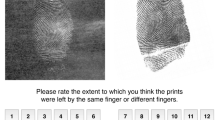Abstract
This paper addresses the problem of analyzing biological pattern recognition systems. As no complete analysis is possible due to limited observability, the theoretical part of the paper examines some principles of construction for recognition systems. The relations between measurable and characteristic variables of these systems are described. The results of the study are:
-
1.
Human recognition systems can always be described by a model consisting of an analyzer (F A) and a linear classifier.
-
2.
The linearity of the classifier places no limits on the universal validity of the model. The principle of organization of such a system may be put into effect in many different ways.
-
3.
The analyzer function F A determines the transformation of external patterns into their internal representations. For the experiments described in this paper, F A can be approximated by a filtering operation and a transformation of features (contour line filter).
-
4.
Narrow band filtering (comb filter) in the space frequency domain is inadequate for pattern recognition because noise of different bandwidths and mean frequencies affects sinusoidal gratings differently. This excludes the use of a Fourier analyzer.
-
5.
The relations between the measurable variables, which are the probabilities of detection (P D curves), and the characteristic variables of the recognition system are established analytically.
-
6.
The probability of detection not only depends on signal energy but also on signal structure. This would not be the case in a simple matched filter system.
-
7.
The differing probabilities of error in multiple detection experiments show that the interference is pattern specific and the bandwidth (steepness of the P D curves) is different for the different sets of patterns.
-
8.
The distance between the reference vectors in feature space can be determined from the internal representation of the patterns defined by the model. Through multiple detection experiments it is possible to determine not only the relative distances between the patterns but also their absolute position in feature space.
Similar content being viewed by others
References
Bohn, G.: A structure of associative information processing. Biol. Cyb. 29, 193–200 (1978)
Fansa, M., v. Seelen, W.: On the classification of visual patterns: System analysis using detection experiments. Biol. Cyb. 25, 121–130 (1977)
Papoulis, A.: Probability, random variables and stochastic processes. Tokyo-London-Sydney: McGraw-Hill Kogakusha Ltd. 1965
v. Seelen, W.: Zur Informationsverarbeitung im visuellen System der Wirbeltiere. II. Kybernetik 7, 89–106 (1970)
v. Seelen, W.: Methoden zum Vergleich des Leistungsvermögens biologischer und technischer Systeme. Kybernetik 10, 1–16 (1972)
Steinhaben, H. E., Fuchs, S.: Objekterkennung —Einführung in die mathematischen Methoden der Zeichenerkennung. Berlin: VEB Verlag Technik 1976
Winkler, G.: Stochastische Systeme, Analyse und Synthese. Wiesbaden: Akademische Verlagsgesell schaft 1977
Author information
Authors and Affiliations
Rights and permissions
About this article
Cite this article
Türke, B. Analysis of pattern recognition by man using detection experiments. J. Math. Biology 13, 47–65 (1981). https://doi.org/10.1007/BF00276865
Received:
Revised:
Issue Date:
DOI: https://doi.org/10.1007/BF00276865




